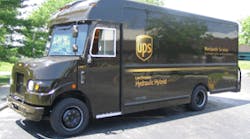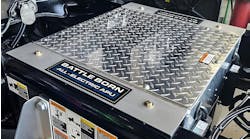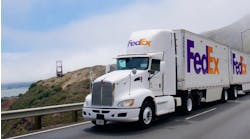The U.S. Environmental Protection Agency has announced the road test of a United Parcel Service hybrid delivery vehicle, which was developed in partnership with International Truck & Engine Corp., Eaton Corp. and the U.S. Army. EPA says that laboratory testing of the technology demonstrated a 60-70% improvement in fuel economy and a 40% reduction in greenhouse gases. EPA and UPS plan to evaluate the vehicle’s fuel economy performance and emissions during a series of tests this year.
According to a joint release from UPS, Eaton and International, this is the first “series” hydraulic hybrid delivery vehicle. In a series hybrid, the diesel engine is not connected to the wheels, but rather powers the hydraulic system, which in turn spins the wheels.
“If parallel hybrids are an evolutionary step, series are a revolutionary step,” Brad Bohlmann, mechanical engineer and business development coordinator at Eaton Corp.’s Fluid Power Group told FleetOwner. However, he doesn’t believe that the series hybrid systems will render the parallel systems obsolete in the long run. “We believe [the new UPS truck] will provide within the next year a groundwork of information to provide people information on whether to buy a series hybrid or parallel. I regard the series hybrid as part of a portfolio of hybrid products Eaton is in the process of manufacturing. I firmly believe there’s a market for both series and parallel hydraulic hybrids.”
EPA estimates that the added upfront cost for the hydraulic components could be recouped in less than three years. Given today’s fuel prices, the vehicle could net a savings that could exceed $50,000 over the span of its lifetime in delivery, refuse, shuttle and transit bus applications, EPA said.
“The operational savings this vehicle could yield is based on three aspects,” Bohlmann said. Eaton and the U.S. Army developed the hydraulic technology powering the truck.
“First is the fuel savings—because the series hydraulic system acts as a continuously variable transmission,” Bohlmann said, explaining that the diesel engine runs separately from the vehicle speed. “That allows you to run the engine at a speed load point that is at or near the optimal setting. Second is its regenerative nature. With this system we could save 70% of the vehicle’s kinetic energy when decelerating and use it for acceleration. It’s free energy. And last, brake maintenance is reduced substantially. The brake life is quadrupled, according to EPA estimates.”
The vehicle features a full hydraulic hybrid powertrain and a hydraulic-hybrid propulsion system integrated with the drive axle. The energy stored in hydraulic motors and hydraulic tanks when brakes are applied is reused to help accelerate the vehicle.
According to Eaton, the diesel hydraulic hybrid truck may be eligible to qualify for a tax credit up to 40% of the incremental cost of the vehicle under a provision of the Energy Policy Act of 2005 for medium- and heavy-duty vehicles.
The vehicle is on a road tour of EPA regional offices and will deliver UPS packages in the Detroit area this summer. UPS and EPA will assess the vehicle’s performance as it completes normal commercial operations.
Hydraulic hybrid technology is on the cusp of being commercially available from Eaton. A parallel hybrid system called the Eaton Hydraulic Launch Assist (HLA) will be offered commercially starting in 2007. Eaton said that after its HLA hybrid—which initially will be rolled out for the refuse market—proves its commercial viability, it “will provide our customers with the confidence to consider the series hybrid when it is commercialized.”
The UPS truck chassis was provided by International Truck & Engine Corp.
For more information, go to http://www.epa.gov/otaq/technology/recentdevelopments.htm or http://www.eaton.com/NASApp/cs/ContentServer?pagename=EatonCom/Pages/PressRelease_Details&cid=1143077875904



